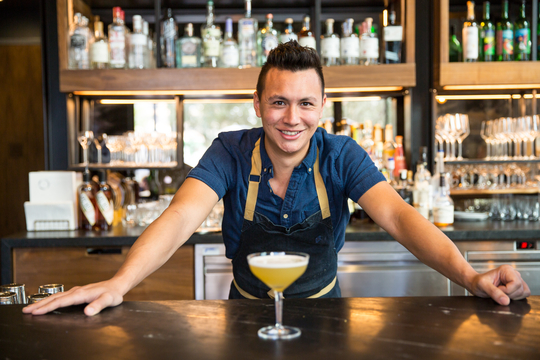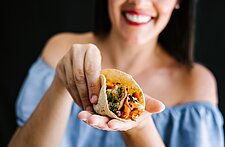When most folks think of seasonality it’s normally in preparation of Winter, Spring, Summer and Fall; but when consumers, more specifically foodies, think of seasonality it is usually in anticipation of pumpkin spice lattes or breast cancer pink cookies. At Symrise we are constantly looking for ways to innovate and that means going beyond the scope of normal. It also means not only looking for inspiration within, but outside of the box — our box being the food and beverage space. To do that, we teamed up with Brand Genetics to interview eleven experts spanning several, very different industries to get their take on seasonality in hopes of guiding you on your path to being informed, inspired, and innovative.
Join The In-Sight Community, Subscribe To The Weekly Newsletter!
 We sat down with Chris Amirault, Bar Program Director of Otium based in Los Angeles to talk seasonality in the restaurant space. You can read more about Chris’ illustrious career in the cocktail space via one of Symrise's partners, Starchefs.
We sat down with Chris Amirault, Bar Program Director of Otium based in Los Angeles to talk seasonality in the restaurant space. You can read more about Chris’ illustrious career in the cocktail space via one of Symrise's partners, Starchefs.
Where or what do you get your inspiration from?
I use ingredient based — seasonality charts. On the more abstract side, looking at paintings, listen to a song, and going to an art museum — color, sound, and texture can all lead to new ideas so I always have an observational prowl. We actually once had an arts theme inspired by a Jeff Koons sculpture which translated into a gold cocktail with elements of dehydrated Fiji and honey apples. Some customers are curious about inspiration so we tell them, it can be a really cool talking point. Relating to the product at a human level increases the experience by creating a connection.
What are some of the challenges you face with seasonality in the cocktail space?
Well seasonality is a hard thing to do especially as a lot of bars are themed nowadays. Some guests’ reaction of changing menus show that they are looking for stability. Micro-seasons are also a challenge. If I have 3 weeks of golden raspberry I have to take into account how I can get enough products to make it profitable (volume) and the prep time — the longer the season the better.
Thirsty For More Drink Insights? Find More Here!
There’s also much more application in food especially as more nontraditional ingredients make their way from the garden to the glass. It requires a bit of a culinary background and understanding which many bartenders don’t have. A simple trick to overcome any initial customer intimidation with this is to think of a familiar ingredient or family of cocktails that people are used to and use that as your foundation.
What are your thoughts on the future of seasonality and where it is headed?
I think we will see a lot of mixes of existing products with elements of 80’s and 90’s trends — think Frojitos, Frozé, Friesling, etc.
Do you have any advice you’d like to share?
 Farmers markets are the perfect places to find out what’s in season and what’s not — go the whole year and map out the seasons and their ingredients. Talk to the farmers themselves, get feedback on specific batches, and ask about the micro-seasons too. When you go out to drink or eat, pay attention to the menus, look for everything from flavor profiles to ingredient combinations. Create a reference book, flavor bible, etc. — this will essentially be your encyclopedia of ingredients and possible combinations, similar flavor profiles, and ideal seasons. Diversify your sources of inspiration, see what’s going on both within and outside of your space, and find unusual pairings by deconstructing flavors to understand the combinations.
Farmers markets are the perfect places to find out what’s in season and what’s not — go the whole year and map out the seasons and their ingredients. Talk to the farmers themselves, get feedback on specific batches, and ask about the micro-seasons too. When you go out to drink or eat, pay attention to the menus, look for everything from flavor profiles to ingredient combinations. Create a reference book, flavor bible, etc. — this will essentially be your encyclopedia of ingredients and possible combinations, similar flavor profiles, and ideal seasons. Diversify your sources of inspiration, see what’s going on both within and outside of your space, and find unusual pairings by deconstructing flavors to understand the combinations.
The biggest takeaway from this series of interviews is that seasonality is about about novelty (think charcoal ice cream), flavor (pumpkin spice latte), functional benefit (plant-based everything), association (gingerbread cookies during Christmas), excitement (unicorn frappe), and priming (marketing). It is also a reflection of our world — weather, time of year, ingredients, locales, cultures, etc. Seasonality can be a good product development tool with the right balance of market curation and experimentation. At the same time, it can be expensive and hard to pull off without a healthy balance of change and stability.
This series is backed by our Seasonality Initiative where we help our customers develop pipelines of new concepts and flavor ideas for the seasons and major holidays. If you have questions or would like to learn more about our initiative please contact us.
Continue With The Seasonality Series Here!
All images are courtesy of @OtiumLA on Instagram.






